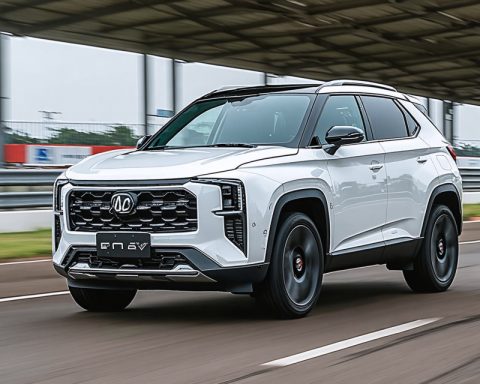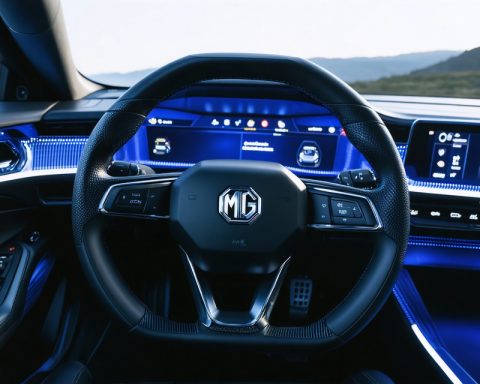- Autonomous vehicles, led by companies like WeRide, Baidu, and Pony.ai, are advancing rapidly but face significant financial losses and hurdles in achieving profitability.
- WeRide has reported mounting losses, highlighting the high costs of developing self-driving tech suitable for complex urban environments.
- Key challenges include navigating government regulations and the lack of cohesive global policies, which hinder the path to profitable operations.
- Regulatory milestones are deemed essential by industry leaders for driving forward profitability, yet progress is stifled by slow bureaucratic processes.
- U.S. automakers are urging federal intervention to establish a clear regulatory framework, fearing they may fall behind China’s advancements without it.
- The success of the autonomous vehicle sector depends not just on technological breakthroughs but on strategic, forward-thinking policy development.
With support from major tech players like Nvidia, WeRide is at the forefront of autonomous driving initiatives, boasting partnerships and trials across the globe. However, as the company’s financial statements make clear—recent losses have soared to RMB 2.5 billion ($342 million) in 2024—the dream of a driverless future comes at a steep price. The landscape is fraught with substantial challenges, not the least of which are the prohibitive costs of developing cutting-edge technology capable of navigating complex urban environments.
While executives like Tony Han, WeRide’s visionary founder, express optimism about the future, realistic assessments of current conditions are less rosy. The pursuit of profitability is marred by the labyrinthine path of government regulations and the absence of cohesive global policies. Han underscores the necessity of regulatory milestones, which, if realized, could catalyze profitable operations. But as the sands of bureaucracy shift slowly, the horizon remains stubbornly distant.
Across the Pacific, U.S. automakers echo similar frustrations. Their voices grow louder, desperately calling for the federal government to carve out a definitive regulatory path. Worries abound that without swift government intervention and policy advancements, the U.S. may find itself lagging behind China’s fast-paced advancements in the autonomous sector. The industry’s chorus is clear: if America does not act soon, it risks becoming a spectator in a race where it once led.
Herein lies a key takeaway: the future of autonomous vehicles hinges not solely on technological triumphs but equally on strategic policy development. Without a concerted effort to iron out regulatory ambiguities and propel forward-thinking policies, the path to profitability will remain an uphill battle.
The vehicle of innovation races onward, its engine roaring with the power of unprecedented technological progress. Yet, without timely regulatory backing, the finish line for profitability remains elusive. In this race towards autonomy, it takes more than cutting-edge technology to win; it takes a roadmap of clear, consistent, and conducive policies to usher these pioneers towards a profitable future.
Will Autonomous Vehicles Ever Turn a Profit? The Financial Reality Behind the Self-Driving Boom
The Current Landscape of Autonomous Vehicle Development
The burgeoning field of autonomous vehicles paints a futuristic picture with cars zipping through streets autonomously. However, the financial reality for leaders like WeRide, Baidu, and Pony.ai is fraught with mounting losses and an elusive path to profitability. These companies are at the forefront of technological innovation but face significant financial challenges.
Financial Challenges
– High Development Costs: Developing the technology required for autonomous driving, especially in complex urban environments, demands substantial financial investments. WeRide, for instance, reported losses reaching RMB 2.5 billion ($342 million) in 2024.
– Regulatory Barriers: The route to profitability is obstructed by complex government regulations and a lack of unified global policies. Companies like WeRide stress the importance of regulatory milestones to drive profitable operations.
Industry Trends and Predictions
– Partnerships and Collaborations: Companies like WeRide benefit from partnerships with major tech players, such as Nvidia, which provide essential support in technology development and trials worldwide.
– Continued Investments: Despite financial losses, there is an ongoing influx of investments aimed at refining and scaling autonomous vehicle technologies. However, the return on these investments remains a distant prospect.
Pressing Questions and Insights
What are the key obstacles to profitability for autonomous vehicle companies?
The chief obstacles include high R&D costs, lengthy regulatory approval processes, and the need for extensive real-world testing to ensure safety and reliability.
How are U.S. companies positioned in the autonomous race compared to China?
U.S. companies face similar frustrations with regulatory hurdles. There is a growing call for the federal government to establish clear policies to prevent falling behind China’s fast-paced advancements in the sector.
What needs to change for autonomous vehicles to reach profitability?
A concerted effort is needed to streamline regulatory requirements and develop forward-thinking policies. Strategic collaborations and technological advancements are crucial, but without regulatory reform, profitability remains uncertain.
Actionable Recommendations and Quick Tips
– Innovative Solutions: Companies should focus on creating scalable solutions that can adapt to diverse regulatory environments and urban landscapes.
– Policy Advocacy: Engage with policymakers to accelerate the development of clear and consistent regulations that support autonomous vehicle deployment.
– Cost Management: Explore cost-effective methods and partnerships to minimize R&D expenditures while maintaining progress in technology development.
Pros and Cons Overview
– Pros: Cutting-edge technology, potential safety improvements, reduced traffic congestion.
– Cons: High development costs, regulatory challenges, potential job displacement.
Related Articles
– Explore more about the latest trends in autonomous vehicles and technology innovations at Wired.
In conclusion, while the vision of a driverless future captivates our imaginations, the journey to profitability is complex and requires not only technological innovation but also robust policy frameworks. As the industry evolves, stakeholders must work closely with regulators to navigate the intricate landscape and ensure a sustainable, profitable future for autonomous vehicles.

















